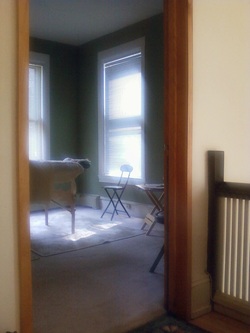What to expect at a session

At the beginning of the session, you'll be given a form to fill out informing me of any medical issues, and asked a few questions about how you're doing today physically. I will leave the room so that you can undress to your own level of comfort and settle yourself on the table covered with a sheet. During the session you will be wrapped according to New York State guidelines, so that you will never feel overly exposed or uncomfortable while receiving the massage.
I generally begin a massage with light, gentle rocking and palpation in order to better understand where you're holding tension and to quickly facilitate the relaxation response within you. I will check in on various occasions to check depth of pressure as we go further into the massage and to make sure you are comfortable. I will seek to work on issues that we've discussed beforehand using a variety of modalities to assist in relieving tension, increasing range of motion and improving circulation. Different types of techniques that I may use are listed below.
Sometimes during a session, you may need to get up to use the restroom. There will be a bathrobe available for your convenience. The release of long held tension can sometimes result in an emotional reaction such as crying or laughing. This is perfectly all right. The objective is to help you let go and arrive at the relaxation point which may assist in your healing, centeredness and self awareness for a better way of living.
At the close of the massage, I will leave the room to allow you to collect yourself and dress. You will be given a glass of water to help you replenish and flush out any toxins that have been released during the massage.
When scheduling a massage, please allow yourself time afterward to enjoy your day and fully reap the benefits by avoiding scheduling any hectic appointments too close to the end of the massage time.
I generally begin a massage with light, gentle rocking and palpation in order to better understand where you're holding tension and to quickly facilitate the relaxation response within you. I will check in on various occasions to check depth of pressure as we go further into the massage and to make sure you are comfortable. I will seek to work on issues that we've discussed beforehand using a variety of modalities to assist in relieving tension, increasing range of motion and improving circulation. Different types of techniques that I may use are listed below.
Sometimes during a session, you may need to get up to use the restroom. There will be a bathrobe available for your convenience. The release of long held tension can sometimes result in an emotional reaction such as crying or laughing. This is perfectly all right. The objective is to help you let go and arrive at the relaxation point which may assist in your healing, centeredness and self awareness for a better way of living.
At the close of the massage, I will leave the room to allow you to collect yourself and dress. You will be given a glass of water to help you replenish and flush out any toxins that have been released during the massage.
When scheduling a massage, please allow yourself time afterward to enjoy your day and fully reap the benefits by avoiding scheduling any hectic appointments too close to the end of the massage time.
Trigger Point Therapy
Often when a client complains of a "knot" in a muscle, that spot is a trigger point. A trigger point is like a traffic jam in the muscle bundle, an area that is held in flexion that the brain has forgotten about. When pressure is applied to these spots, there is often referred pain in other areas of the body. When applied pressure is held on a trigger point for 30 to 90 seconds, the brain remembers to pay attention to the area and will work out the issue. Often the tension will reduce or dissolve and the muscle will become supple again, relieving pain.
Kinesthetic Awareness through MovementKinesthetic Awareness through Movement is a technique that accesses the water in the body as a tool for massage. About 70% or more of the adult human body is made up of water. This modality utilizes gentle rocking to get the water in the body moving back and forth in a wave-like action, in effect washing away tension.
Connective Tissue Therapy
Also known as Myofascial Release or Deep Tissue Massage, Connective Tissue Therapy acts on the fascia that encases every muscle and creates a network throughout the entire body. By using very slow, specific strokes, hydrogen bonds are released in the connective tissue matrix turning it from a gel state to a more liquid, or "sol" state. This allows adhesions to be dissolved and long-held toxins to be flushed out. This type of therapy can be deep and profound. Like pulling on a sweater, it can effect the entire weave of the connective tissue.
Swedish Massage
Swedish Massage is general systematic massage of the muscles, ligaments and tendons of the body to induce a state of deep relaxation. It increases the body's blood and lymphatic circulation. Probably the best known form of massage, because of its overall contact of the muscles and use of oils, Swedish Massage can feel wonderfully satisfying and nurturing and is a good basis from which to start, mixing in the above mentioned techniques for more specific issues.
|